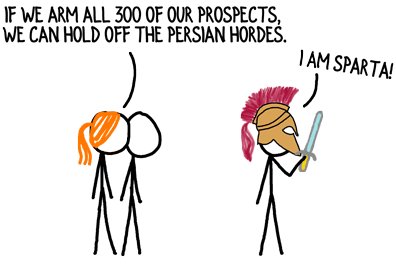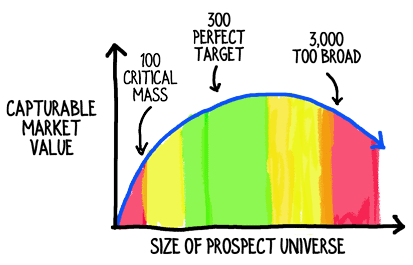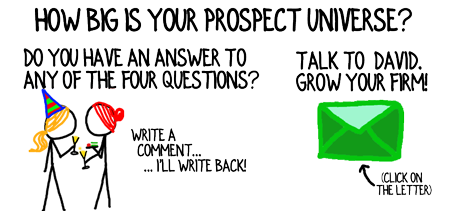How many prospects should there be in your consulting firm’s target market? The more the merrier, right? Not really. There’s a lower limit and an upper limit on your perfect target market size for your boutique consulting firm.
It’s sort of like Debauve & Gallais truffles. Savoring one D&G truffle leaves you crying for another taste. A thousand truffles would bury you, and when they cause you to max out your bathroom scale they’d probably lose their appeal. You have to find the right balance. A one-pound box is just perfect.**
The same holds for the target market of your consulting firm. Too few will leave you hungry for more clients. Too many will make you unattractive. (More on that, in a moment.)
What’s the right balance for your consulting firm? Roughly 300 prospects in your target market.
Three hundred prospects is perfect for a boutique consulting firm to build a $3-$10m practice area. That same number is also the right size for a solo practitioner to build a solid, $450k-$1m practice.

Of course, the dangers of too small a target market are obvious. If there are only one or two truffles in the box and someone else snatches them up, you’re out of chocolatey goodness.
While I’ve seen consulting firms build to $10 million in annual revenue with only a handful of solid clients, and perhaps 20-50 in their Network Core, that’s a risky, long-term financial model.
The downsides of too large a target market are less obvious. If you were running a large consulting firm or a mass-market consumer products company, you might want as large a market as possible.
But you’re not. You’re running an independent consulting firm. You’re D&G, not Hershey. Highly successful boutique and solo consulting firms tend to have smaller target markets than their less-successful counterparts.
Once you get past the friends-and-family stage, clients engage your boutique consulting firm because you have deep experience in their exact situation— usually you’re well versed in their industry and in solving the precise problem they’re facing.
If your target market definition expands too much, you look like a generalist and you become less attractive to new clients than competitors who specialize.

300. Got it. Now what?
First, take a hard look at the current definition of your consulting firm’s target prospect. To help you complete this exercise, define your consulting firm’s prospects using two sets of attributes:
| Qualifiers (All must apply) | Descriptors (What could describe the decision maker) |
|
|
Does your definition create a pool of 30 or 300 or 3,000 or 30,000 prospects? If it’s too broad, tighten the descriptive attributes or narrow the scope of the problem you solve.
Once you’ve created a definition of your target that leads you to the right size prospect universe, you can start a visibility-building campaign.
- Using LinkedIn, public databases, and your industry contacts and knowledge, compile a list of as many prospects as possible, with specific names and contact information.
- Starting with the folks you already know, then expanding through referrals and introductions, reach out to your target prospects.
- Nurture relationships with your target 300.
When your Network Core harbors 300 A1s (i.e., 300 decision-makers who will engage in conversation), you’re perfectly positioned to enjoy a successful, lucrative consulting practice.
Out of curiosity, I’m interested in your answer to any of the following questions:
What’s your current target market?
How many decision makers do you estimate are in your current target market?
Do you think you should expand or narrow your focus, or keep it exactly as is?
Does anyone make better truffles than Debauve & Gallais?
Text and images are © 2024 David A. Fields, all rights reserved.

 David A. Fields Consulting Group
David A. Fields Consulting Group 

That’s exactly my question and one I was hoping to read about! Which market should I target as my niche and build my consulting business around? My engineering and R&D problem solving experience in the semiconductor market was decades ago before the 2001 crash, so I’m no longer up on current tools (or network!) and most manufacturing has moved overseas. I’ve run single person freelancing lifestyle businesses ever since, and my most recent company has met my goals since 2009. But I want to do more consulting (helping others solve problems is more rewarding) and would love your advice on selecting/locating a niche with A1 needs/contacts that are inside my very wide, very broad generalist experience realm. You’ve hit on my problem exactly! Fodder for another article?
Picking the right niche is, as you say, a critical step in establishing a rewarding consulting firm. Fortunately, a smart engineer like you will easily be able to pick up the skills and knowledge you need to solve today’s problems.
Start with the Problemeter exercise, which is described in The Irresistible Consultant’s Guide to Winning Clients, and explained in detail in one of the bonus resources.
Interesting read. Two questions..
1) One reference above is to build a target market of 300 and later the article mentions a network core of 300. Are network core and target market different words for the same thing?
2) In the exercise, can you apply all 4 descriptors to reach your target of 300 or does one need to narrow the descriptors down?
Great questions, Debbie.
Thanks for the helpful article.
Core network is currently 59.
I think I need to narrow my focus.
When I get to 300, I’ll reward myself with those yummy truffles.
Sounds like a good plan, Debbie. My recommendation is to reward yourself a couple of truffles today. After all, you have 60 prospects in your Network Core already and that’s a great start!
I’d like to hear more about the truffles ????
Unsweetened cocoa powder dusted on the outside of a dark chocolate shell; glorious, creamy chocolate center. Minimal ingredients, all of the highest quality, with no fillers or preservatives. All elegantly packaged and delivered. Sublime.
What to do if your target market/ideal client is actually best described by disposition/values? My ideal client isn’t easy searchable on something like LinkedIn because they tend to cut across lots of different position titles and industries.
Interesting question, Coonoor. First and foremost, your target clients have to be reachable by you. That’s the #1 attribute of a prospect: you can reach them! If you can’t find them, then you can’t reach them and they’re not an ideal prospect.
You must have a way for you to identify your target (or, for them to easily self-identify and come to you). Situation–a descriptive attribute–may cut across industry and position. For instance, “Newly promoted manager” may be a situation, or “Executive who is facing an impending merger” is a situation. Both can be identified by keeping abreast of the news or by asking your current contacts whether they’re aware of someone in that specific situation.”
Be careful not to let your target definition get too broad. I’d worry that a target defined by disposition/values is more likely to have 3 million prospects than 300.
Thanks for posing your situation–it’s probably very helpful for quite a few readers.
David – Thank you for the article. Could you elaborate on the 300 number? I assume there is an implicit assumption of success rate, $ per client, time available to develop business, time needed per client, etc. Thanks LZ
You’re absolutely right, Luiz. The 300 number is based on a number of assumptions and calculations. The assumptions are based on the following:
I have benchmarks for all these assumptions, and they vary a bit by size of firm and focus of the consultancy; however, they all lead nicely to the 300-ish number.
You’ve asked an insightful question, and we can talk about the specifics for your firm offline, if you’d like.